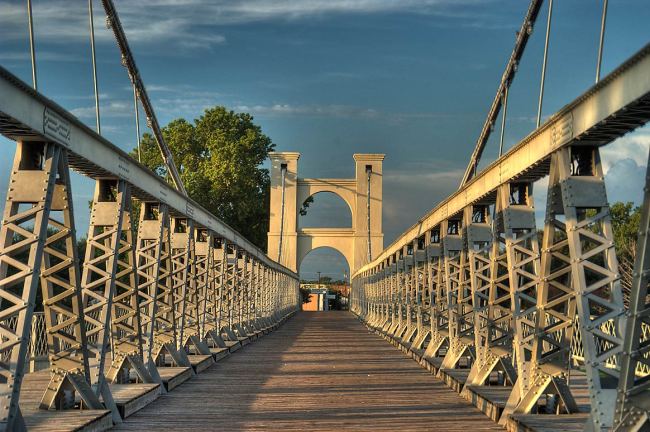by The Waco Kid
This article is an op-ed and the opinions therein may or may not be reflected by the staff, founders, or contributors of
I Am A Texan, LLC.
Summary
For 40 years, American leaders have talked about the need for an energy policy and the need to stop importing foreign oil and, 40 years later, here we are. People point to the housing crisis as the source of our current economic problems. What people forget is that oil prices nearly doubled in the year before the downturn because the global economy was
doing well and demand for oil was strong. If good times return, won’t we go back to the same supply and demand problem? If we don’t get off oil, we are dooming ourselves to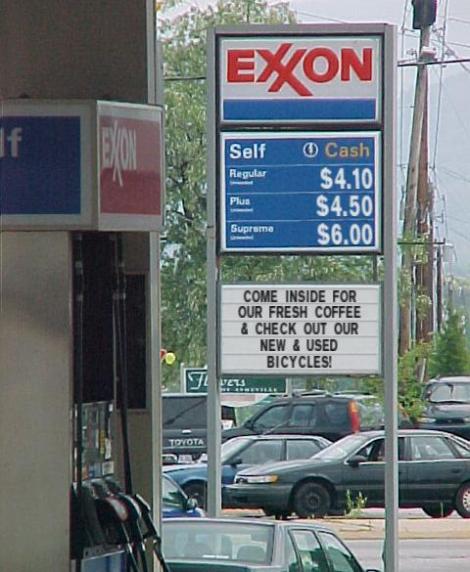 more economic busts. It is in our economic interests to invest in energy solutions now.
more economic busts. It is in our economic interests to invest in energy solutions now.
America has a solution in wind energy, but the current wind strategy of building windmills connected to population centers by copper lines is not a comprehensive solution. I propose a radically different way of using wind energy that allows America to become energy self sufficient, environmentally cleaner, a greater producer of food, and an exporter of clean energy throughout the world. And this idea would create hundreds of thousands of jobs now and for the future, and increase America’s wealth.
Current wind generators need constant wind speeds because our electric grid uses constant transmission rates. Gears inside wind generators keep them from spinning too 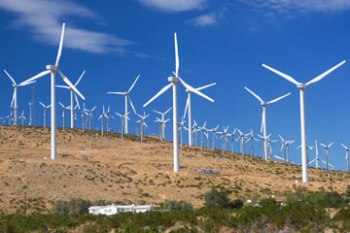 fast. A windmill produces as much electricity when the wind is blowing 60 miles per hour as it does when the wind is blowing 20 miles per hour.
fast. A windmill produces as much electricity when the wind is blowing 60 miles per hour as it does when the wind is blowing 20 miles per hour.
I would take off the gears. Electricity generated by my windmills could be put into transmission lines at constant rates and it could be used to split water into hydrogen and oxygen. The hydrogen would be stored and used to generate electricity at power plants when needed.
This requires a new transmission system with three components: a water pipeline, a hydrogen pipeline, and a superconductor electric line.
- The water could come from sources like the Great Lakes or Mississippi or Missouri rivers and would be used to create the hydrogen. Since water would now be delivered to farms where the windmills are located, irrigation equipment could be attached
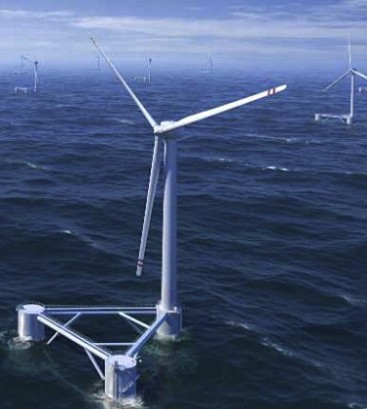 directly to the windmills allowing farmers to significantly increase food production. Only a small percentage of farms in the plains states are currently irrigated.
directly to the windmills allowing farmers to significantly increase food production. Only a small percentage of farms in the plains states are currently irrigated. - The hydrogen line would take the hydrogen to generating plants where it could be stored and used to create electricity when needed, and the hydrogen could end up at seaports where it can be loaded on ships and sold overseas as clean energy bringing money and jobs to America.
- And the superconductor line could transport electricity without the transmission loss of copper wires. The inability to efficiently transport electricity from the Great Plains to places like Florida is why wind power hasn’t caught on already. It’s not practical to just build a superconductor line, but we’re combing it with the hydrogen line and the water line to achieve a comprehensive solution.
It will take the federal government to create the distribution system and impose the tax to pay for it.
With our ability to create all of the electricity and hydrogen that we need, America would have to convert to hydrogen powered cars. To make this happen, the government will have to require gas stations to offer hydrogen fuel. We’re currently in a chicken and the egg situation with car makers not making hydrogen powered cars because the fuel is not available and gas stations not offering hydrogen because there are no hydrogen powered cars. We have to break the stalemate by requiring hydrogen fueling stations.
Americans know that we have to get off oil. Americans know that if we don’t get off oil, there will be more price spikes that will hurt our economy in the future. Americans know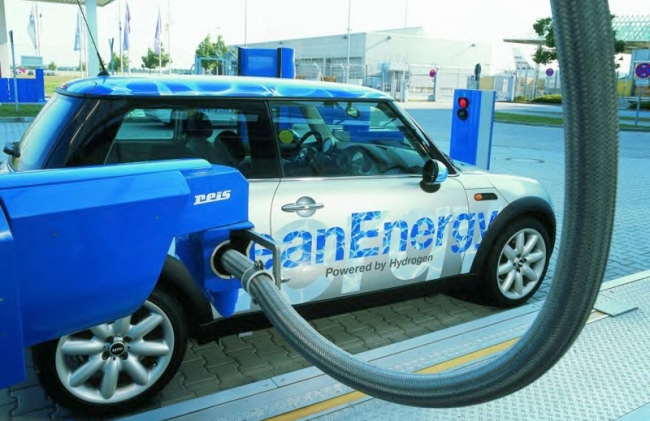 that we will have to pay for the infrastructure investment to get off oil. Americans know that if we make that investment now, we will create much needed jobs now. Americans know that if we are energy self sufficient we will be a wealthier nation and, if we become a supplier of clean energy to the world, we’ll be an even wealthier nation. My idea achieves this.
that we will have to pay for the infrastructure investment to get off oil. Americans know that if we make that investment now, we will create much needed jobs now. Americans know that if we are energy self sufficient we will be a wealthier nation and, if we become a supplier of clean energy to the world, we’ll be an even wealthier nation. My idea achieves this.
My idea is non partisan and can be liked by people of all political affiliations. It produces jobs. It increases America’s wealth. It increases our national security. It is environmentally friendly. If people can use social media to rise up and overthrow dictators in the Arab world, can’t Americans rise up and demand better from our elected leaders? If you like this idea, let your voice be heard. Like me on Facebook and spread the world. Send your elected leaders a link to my website. After 40 years, it’s time to quit talking and start doing when it comes to energy.
Details
Richard Nixon appointed the nation’s first “energy czar” in 1971. Forty years later, here we still are without a vision, strategy, or policy to deal with our energy needs. I propose a vision of an America that is not only rid of our dependence on foreign oil but one that makes the United States into an exporter of clean energy to the world.
The plan involves
- A radically different way of using wind energy that also increases our agricultural production
- Building a new energy and water distribution system throughout the country
- Converting automobiles to run on hydrogen fuel
The new windmill
Today’s electric producing windmills like constant wind speeds because the electric grid is based on constant transmission rates. If the wind is blowing too fast, gears inside the windmill keep the generator from spinning too fast and producing too much electricity. A windmill produces as much electricity when the wind is blowing 60 miles per hour as it does when the wind is blowing 20 miles per hour. This means that the prime locations for windmills today are limited to where the wind speed is more constant, and it means that windmills don’t take advantage of higher than normal winds or gusty conditions.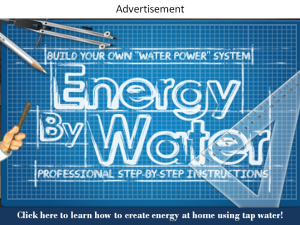
Today’s windmills also only produce electricity. The electricity cannot be stored, and it cannot be increased based on need because the energy produced is solely dependent on current wind speeds.
My new windmill works differently. Imagine a wheat field on the Great Plains, and think of the field as being like a checkerboard. Inside each square is a windmill. Each windmill is connected to each other by underground pipes, and the underground pipes all go to a command center at the corner of the field. The new windmill spins as fast as it can. The electricity goes to the command center where it can go directly into the grid, or it can be used to split water into hydrogen and oxygen, or it can be used for both purposes. The hydrogen is piped to a storage facility for use later.
Is it inefficient to split water into hydrogen and use it later? Yes. The current system loses energy because of the limits placed on how fast the windmills can turn. My system loses energy in the creation of hydrogen. However, this inefficiency results in an energy source that can be transported and used when needed. The current system’s inefficiency results in the need to limit windmills to certain areas with constant wind and to build more windmills to meet demand when wind speeds are low.
My windmills can also serve a dual purpose. Under the checkerboard field, the pipes connected to the windmills have an electric line for taking the electricity to the command 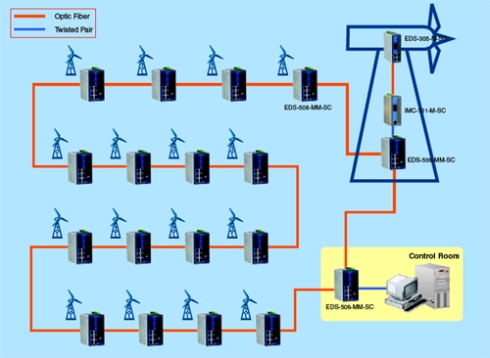 center and a water pipe for taking water to the windmills. Well under the blades on the windmill pole, there would be an irrigation pipe. It is stored in an upright or vertical position, and it could be lowered to a horizontal position and circle around pole to irrigate our wheat field. Irrigation can significantly increase crop yields. Our windmill is serving two purposes: producing electricity and producing more food. This dual purpose makes the windmill more cost effective. And when thinking of our crop irrigation model, don’t assume that windmills have to be the same size that you see today. They could be smaller and placed closer together to accommodate irrigation equipment.
center and a water pipe for taking water to the windmills. Well under the blades on the windmill pole, there would be an irrigation pipe. It is stored in an upright or vertical position, and it could be lowered to a horizontal position and circle around pole to irrigate our wheat field. Irrigation can significantly increase crop yields. Our windmill is serving two purposes: producing electricity and producing more food. This dual purpose makes the windmill more cost effective. And when thinking of our crop irrigation model, don’t assume that windmills have to be the same size that you see today. They could be smaller and placed closer together to accommodate irrigation equipment.
The new distribution system
For this to work, I need to get electricity and hydrogen from the windmills and water to the windmills. That means that a new nationwide distribution system needs to be created. Currently, we use copper wires to transport electricity. It’s easy and cost effective to build, but it’s not completely efficient. Electricity is lost during transmission. The longer the distance, the greater the loss. Transporting electricity from a wind farm in South Dakota to Florida by copper wires would be a problem. There are more efficient ways to transport electricity, but they’re not as cheap to build. The economics change however because the new distribution system transports electricity, hydrogen, and water.
So imagine creating a pipeline system with three pipes buried together, or an over ground pipeline system, or a partitioned concrete sub-ground system with three pipes. One enormous pipe brings fresh raw water 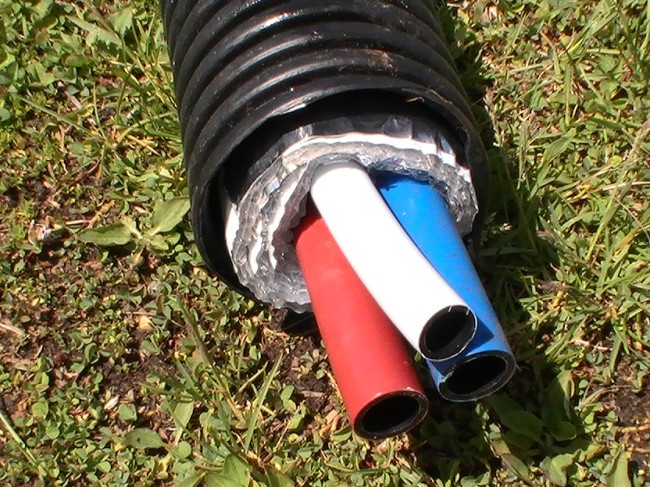 from water sources such as the Mississippi or Missouri rivers or the Great Lakes to the windmill farms. A smaller pipe is a superconductor for transporting electricity from the windmill farm to electric users throughout the country with little to no loss during transmission. And the third pipe transports hydrogen gas or liquid hydrogen from the windmill farms to generating facilities throughout the United States and to seaports so that it can be exported throughout the world.
from water sources such as the Mississippi or Missouri rivers or the Great Lakes to the windmill farms. A smaller pipe is a superconductor for transporting electricity from the windmill farm to electric users throughout the country with little to no loss during transmission. And the third pipe transports hydrogen gas or liquid hydrogen from the windmill farms to generating facilities throughout the United States and to seaports so that it can be exported throughout the world.
Hydrogen Cars
We have to get America off of oil. We don’t produce enough oil to be self sufficient. Our dependence on foreign oil affects our nation’s foreign policy, economy and environment. Our plan can make us completely energy independent, but it requires converting our cars to run on something besides oil.
Electricity is available everywhere, but electric cars currently do not meet the needs of America. The limits on distances that can be travelled and recharging time mean that they cannot replace gasoline powered vehicles today.
Hydrogen powered cars could replace gasoline powered cars without a loss of functionality. Existing engines can be converted to run on hydrogen, or automakers could start making hydrogen fuel cell vehicles. But hydrogen fuel is not widely available. It’s a chicken and egg situation. Car makers won’t make hydrogen vehicles if hydrogen isn’t 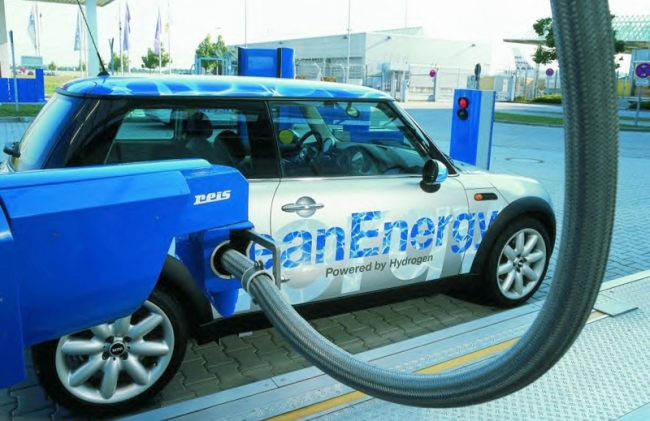 available. Gas stations won’t add hydrogen because there aren’t any cars that use it. The only way to break this stalemate is for the government to require gas stations to sell hydrogen.
available. Gas stations won’t add hydrogen because there aren’t any cars that use it. The only way to break this stalemate is for the government to require gas stations to sell hydrogen.
The politics and economics
I realize that this is a gigantic plan, and that, by this point, you’ve probably cheered parts of the plan and been angered by other parts. I am focused on the overall goal of America achieving energy independence, and I do not believe that it can be achieved without both free market and government action, without compromise of political ideologies, and without patience and sacrifice. We’ve been giving lip service to our energy problem for 40 years. If there were an easy answer, we would have found it by now.
My vision is for an America that uses clean, renewable, domestically produced energy. I have windmills that produce electricity for immediate use and that produce hydrogen for use when needed. And those windmills can also be used to irrigate crops to dramatically increase America’s food production.
Electricity is transported through superconducting lines that eliminate transmission line loss, and the hydrogen is transported to generating facilities in the United States and to seaports where it can be shipped overseas changing America from an energy importing country to an energy exporting country.
Our national security is threatened by our dependence on foreign oil. Energy is a vital component to our national security and, until we become energy independent, our national security is at risk. People who care about our national security should support a plan to make America energy independent.
Our economy would be greatly improved by energy independence. The U.S. Energy Information Administration says that the U.S. imported 11.36 million barrels of oil a day in 2011. That’s more than 4 billion barrels a year, and with oil at about $97 a barrel, we spend about $402 billion on foreign oil a year. Imagine what happens if that money went to windmill operators here. How much stronger would our national economy be with $402 billion dollars staying and circulating here?
Oil prices spike and, when oil prices spike, America ends up in a recession. My new energy system should create stable energy prices. Families will no longer have to sacrifice when oil prices jump, and businesses will benefit from stable pricing.
America needs jobs now. Maintaining the windmills and the distribution system will create steady long-term jobs. And this is an enormous infrastructure project that would create a lot of construction jobs immediately.
How much better off would America be if we become an energy exporting nation, and foreigner energy consumers are creating jobs here by buying energy from us?
People who care about our economic security should support a plan to make American energy independent.
Whether you believe in man-made global warming or not, my plan creates a cleaner, more environmentally friendly energy source. Air quality will improve. If you believe in man-made global warming, you should support a plan that reduces greenhouse gasses. If you don’t believe, you shouldn’t oppose a plan that reduces greenhouses gasses simply because there are people who do believe in global warming and who support the plan.
I understand that this plan will be expensive, but it will create much needed jobs now and is an investment in our future. I also understand that we’ve kicked the can of energy solutions down the road for the last 40 years. At some point, we’re going to have to fix the problem. Why not now?
I call on Congress to create a commission to study this plan and alternatives to achieve energy independence. The commission would estimate how much this plan would cost and report back to Congress. If Congress then believes that this plan is in our national interest, it would authorize the commission to create a tax to pay for the distribution system and begin construction. The tax would be a per kilowatt hour charge so that families and businesses that use more electricity would pay more and those that use less would pay less. The commission would issue bonds to pay for the construction, and the tax would be used to pay off the bonds. When the transmission system is built, the users who transport electricity, hydrogen and water would pay for its operation. When the bonds are paid off, the tax would go away.
To encourage the transition, the commission would loan money to individuals and energy companies at the same low interest rate that the government pays. An electric utility that wants to convert its current generation facilities to run on hydrogen could borrow money from the commission at the same interest rate that the government is charged. The utility may instead want to build hydrogen fuel cell generating facilities. Again it could borrow the money from the government.
A farmer may wish to build windmills and borrow money. Or the farmer may lease his land to be used for windmills and the person or company building the windmills could borrow money. Even foreign utility companies that want to build windmills and export hydrogen could borrow money for investments made in the United States. In all of these cases, the equipment being purchased is collateral and, in all of these cases, American jobs are being created.
It is my hope that this carrot to the energy industry would prevent the government from having to use a stick and require a conversion to the wind/hydrogen economy.
We believe that both the carrot and stick will be required to convert automobiles to hydrogen. We believe that a revenue neutral tax credit and penalty system over a three to five year period could be created. Gas stations that put in a hydrogen fueling station early would get a tax credit. Those who don’t would get a tax penalty. Larger gas and diesel stations would be required to put in a hydrogen fueling station sooner than smaller mom and pop stores.
For example, let’s say this takes effect in the 2013 tax year. If you’re a gas station and you have six or more pumps and you put in a hydrogen fueling station, you get a $2,500 tax credit in 2013, a $1,500 tax credit in 2014, and a $500 tax credit in 2015. If you don’t put in a hydrogen fueling station, you pay a $500 tax in 2013, a $1,500 tax in 2014, and a $2,500 tax in 2015.
What now?
I have offered a vision and a plan to achieve that vision. What’s needed now is leadership. If you like my plan, let someone know. Tell your friends, neighbors, family, Congressman, Senator, President, or special interest group such as farm, environmental, or business or labor group. Share this article on Facebook. Print it out and mail it to your friends who don’t have computers. But do something.
And I don’t have a big ego. If there’s a better plan out there, I’ll eagerly support it. If my plan ends up being the plan or if it simply sparks a discussion and debate that leads to a better plan, I’m okay either way. I simply want America’s energy future to be secure with the best plan possible.
Here are some links about wind energy:
